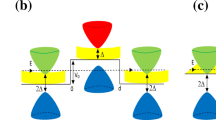Abstract
We will begin our discussion of interband tunneling by considering the square barrier problem for a solid as shown in Fig. 1. Here c and v represent the edges of the conduction band and valence band, respectively, with the forbidden band between them. The straight line represents the constant energy of the electron. In region 1 the electron has band energy
where E c represents the conduction band edge and E 1 is positive. This equation determines a real value of k and corresponds to an eigenfunction of the Bloch form
where u c (x) is the cell periodic part of the conduction-band wave function. The solution is analogous to a plane wave which propagates without attenuation. In the barrier region the band energy of the electron is given by
where E 2 is negative. In this forbidden region k is pure imaginary (in the simplest cases) and the eigenfunctions have the form
.
Access this chapter
Tax calculation will be finalised at checkout
Purchases are for personal use only
Preview
Unable to display preview. Download preview PDF.
Similar content being viewed by others
References
W. Franz, in: Encyclopedia of Physics, Springer-Verlag, Berlin, 1956, p. 155.
E. O. Kane, J. Phys. Chem. Solids 1:249 (1957); Semiconductors and Semimetals, Vol. I, Physics of III–V Compounds (R. K. Willardson and A. C. Beer, eds.), Academic Press, New York, 1967, p. 75.
A. G. Aronov and G. E. Pikus, Soviet Phys.—JETP 24: 188 (1967).
P. M. Morse and H. Feshbach, Methods of Theoretical Physics, Vol. II, McGraw-Hill Book Co. New York, 1953, p. 1565.
E. T. Whittaker and G. N. Watson, Modern Analysis, Cambridge University Press, 1947.
L. V. Keldysh, Soviet Phys.—JETP 6: 763 (1958).
E. O. Kane, J. Phys. Chem. Solids 12: 181 (1959).
E. I. Blount, Solid State Physics, Vol. 13, Academic Press, New York, 1962, p. 305.
J. B. Krieger, Ann. Phys. (N.Y.) 36: 1 (1966).
R. T. Shuey, Phys. Rev. 137:Al268 (1965)
D. R. Fredkin and G. H. Wannier, Phys. Rev. 128: 2054 (1962)
Y. Takeuti and H. Funada, J. Phys. Soc. Japan 20: 1854 (1965).
Author information
Authors and Affiliations
Editor information
Editors and Affiliations
Rights and permissions
Copyright information
© 1969 Plenum Press
About this chapter
Cite this chapter
Kane, E.O., Blount, E.I. (1969). Interband Tunneling. In: Burstein, E., Lundqvist, S. (eds) Tunneling Phenomena in Solids. Springer, Boston, MA. https://doi.org/10.1007/978-1-4684-1752-4_6
Download citation
DOI: https://doi.org/10.1007/978-1-4684-1752-4_6
Publisher Name: Springer, Boston, MA
Print ISBN: 978-1-4684-1754-8
Online ISBN: 978-1-4684-1752-4
eBook Packages: Springer Book Archive




